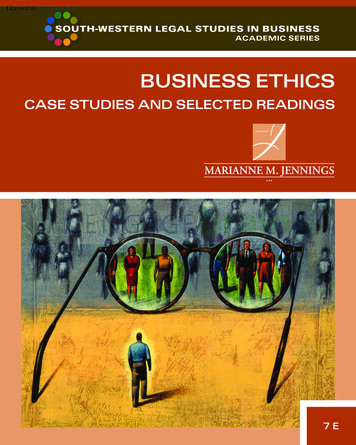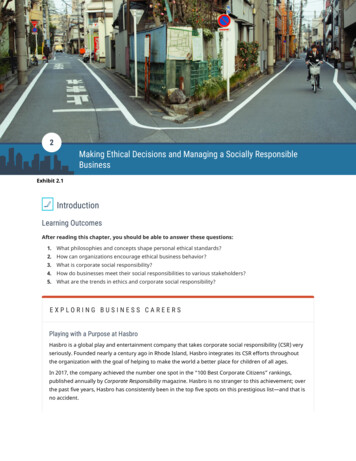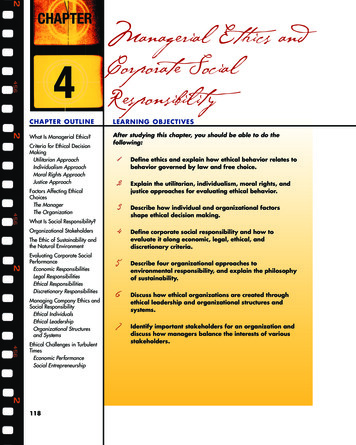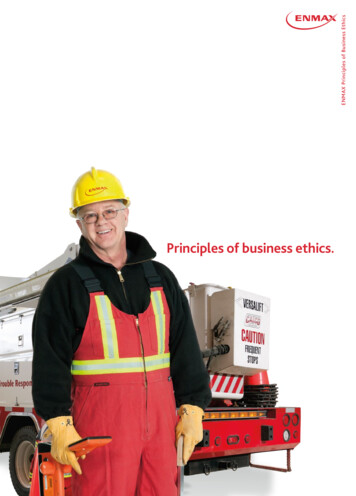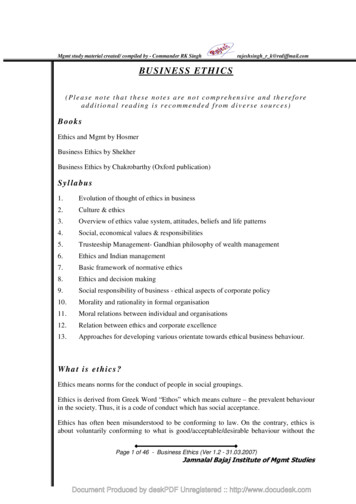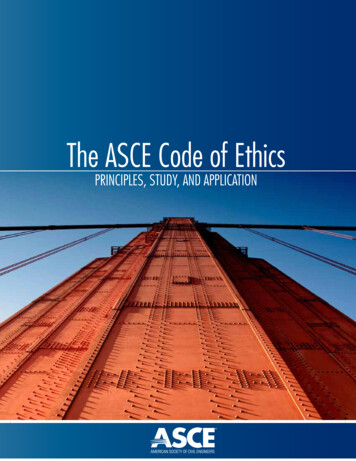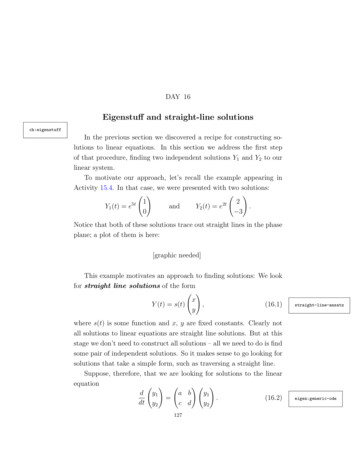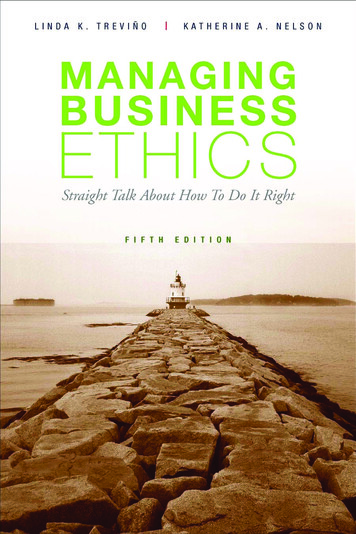
Transcription
E1FTOC07/09/2010Page 4
E1FFIRS07/09/2010Page 1MANAGING BUSINESS ETHICSStraight Talk About How To Do It RightFifth EditionLINDA KLEBE TREVIÑODistinguished Professor of Organizational Behavior and EthicsSmeal College of BusinessThe Pennsylvania State UniversityKATHERINE A. NELSONLecturerFox School of BusinessTemple UniversityJOHN WILEY & SONS, INC.
E1FFIRS07/09/2010Page 2VP & PUBLISHEREXECUTIVE EDITORASSISTANT EDITOREDITORIAL ASSISTANTMARKETING MANAGERMEDIA EDITORPRODUCTION MANAGERASSISTANT PRODUCTION EDITORCOVER DESIGNERCOVER PHOTO CREDITGeorge HoffmanLise JohnsonSarah VernonChelsea TheisKarolina ZarychtaAllison MorrisJanis SooYee Lyn SongRDC Publishing Group Sdn BhdPhoto provided courtesy of Greg KuhnenThis book was set in 10/12 Times Roman by Thomson Digital, and printed and bound by Courier Westford.The cover was printed by Courier Westford.1This book is printed on acid free paper. !Copyright # 2011, 2007, 2004, 1999 John Wiley & Sons, Inc. All rights reserved. No part of thispublication may be reproduced, stored in a retrieval system or transmitted in any form or by any means,electronic, mechanical, photocopying, recording, scanning or otherwise, except as permitted underSections 107 or 108 of the 1976 United States Copyright Act, without either the prior written permission ofthe Publisher, or authorization through payment of the appropriate per-copy fee to the Copyright ClearanceCenter, Inc. 222 Rosewood Drive, Danvers, MA 01923, website www.copyright.com. Requests to thePublisher for permission should be addressed to the Permissions Department, John Wiley & Sons, Inc., 111River Street, Hoboken, NJ 07030-5774, (201)748-6011, fax (201)748-6008, website http://www.wiley.com/go/permissions.Evaluation copies are provided to qualified academics and professionals for review purposes only, for usein their courses during the next academic year. These copies are licensed and may not be sold or transferredto a third party. Upon completion of the review period, please return the evaluation copy to Wiley. Returninstructions and a free of charge return shipping label are available at www.wiley.com/go/returnlabel.Outside of the United States, please contact your local representative.Library of Congress Cataloging-in-Publication DataTreviño, Linda Klebe.Managing business ethics : straight talk about how to do it right / Linda Klebe Treviño, KatherineA. Nelson. – 5th ed.p. cm.Includes index.ISBN 978-0-470-34394-4 (pbk.)1. Business ethics. 2. Business ethics–Case studies. I. Nelson, Katherine A. II. Title.HF5387.T734 20101740 .4–dc222010020659Printed in the United States of America10 9 8 7 6 5 4 3 2 1
E1FTOC07/09/2010Page 3BRIEF CONTENTSSECTION ICHAPTER 1SECTION IICHAPTER 2CHAPTER 3CHAPTER 4INTRODUCTIONINTRODUCING STRAIGHT TALK ABOUT MANAGINGBUSINESS ETHICS: WHERE WE’RE GOING AND WHY2ETHICS AND THE INDIVIDUALDECIDING WHAT’S RIGHT:A PRESCRIPTIVE APPROACH38DECIDING WHAT’S RIGHT:A PSYCHOLOGICAL APPROACH71ADDRESSING INDIVIDUALS’COMMON ETHICAL PROBLEMS111SECTION III MANAGING ETHICS IN THE ORGANIZATIONCHAPTER 5ETHICS AS ORGANIZATIONAL CULTURECHAPTER 6MANAGING ETHICS AND LEGAL COMPLIANCECHAPTER 7MANAGING FOR ETHICAL CONDUCTCHAPTER 8ETHICAL PROBLEMS OF MANAGERS150207255292SECTION IV ORGANIZATIONAL ETHICS AND SOCIAL RESPONSIBILITYCHAPTER 9CORPORATE SOCIAL RESPONSIBILITY322CHAPTER 10 ETHICAL PROBLEMS OF ORGANIZATIONS 354CHAPTER 11 MANAGING FOR ETHICS AND SOCIAL RESPONSIBILITYIN A GLOBAL BUSINESS ENVIRONMENTINDEX399449iii
E1FTOC07/09/2010Page 4
E1FTOC107/09/2010Page 5CONTENTSPREFACEXIIISECTION IINTRODUCTIONCHAPTER 1INTRODUCING STRAIGHT TALK ABOUT MANAGINGBUSINESS ETHICS: WHERE WE’RE GOING AND WHYIntroduction 2The Financial Disaster of 2008 4Borrowing Was Cheap 4Real Estate Became the Investment of Choice 5Mortgage Originators Peddled ‘‘Liar Loans’’ 5Banks Securitized the Poison and Spread It Around 6Those Who Were Supposed to Protect Us Didn’t 7Moving Beyond Cynicism 9Can Business Ethics Be Taught 13Aren’t Bad Apples the Cause of Ethical Problems in Organizations? 13Shouldn’t Employees Already Know the Difference between Right and Wrong?Aren’t Adults’ Ethics Fully Formed and Unchangeable? 16This Book is about Managing Ethics in Business 19Ethics and the Law 20Why Be Ethical? Why Bother? Who Cares? 21Individuals Care about Ethics: The Motivation to be Ethical 21Employees Care about Ethics Employee Attraction and Commitment 23Managers Care about Ethics 23Executive Leaders Care about Ethics 24Industries Care about Ethics 26Society Cares about Ethics: Business and Social Responsibility 27The Importance of Trust 27The Importance of Values 29How the Book is Structured 30Conclusion 32Discussion Questions 32215v
E1FTOC107/09/2010viPage 6CONTENTSExercise: Your Cynicism QuotientNotes 3433SECTION IIETHICS AND THE INDIVIDUALCHAPTER 2DECIDING WHAT’S RIGHT:A PRESCRIPTIVE APPROACH38Introduction 38Ethical Dilemmas 38Prescriptive Approaches to Ethical Decision Making in Business 39Focus on Consequences (Consequentialist Theories) 40Focus on Duties, Obligations, and Principles (Deontological Theories)Focus on Integrity (Virtue Ethics) 46Eight Steps to Sound Ethical Decision Making in Business 52Step One: Gather the Facts 52Step Two: Define the Ethical Issues 52Step Three: Identify the Affected Parties (the Stakeholders) 53Step Four: Identify the Consequences 54Step Five: Identify the Obligations 56Step Six: Consider Your Character and Integrity 56Step Seven: Think Creatively about Potential Actions 57Step Eight: Check Your Gut 58Practical Preventive Medicine 58Doing Your Homework 58When You’re Asked to Make a Snap Decision 59Conclusion 61Discussion Questions 62Exercise: Clarifying Your Values 63Case: Pinto Fires 64Notes 69CHAPTER 3DECIDING WHAT’S RIGHT:A PSYCHOLOGICAL APPROACH71Introduction 71Ethical Awareness and Ethical Judgment 71Individual Differences, Ethical Judgment, and Ethical BehaviorEthical Decision-Making Style 76Cognitive Moral Development 77Locus of Control 84Machiavellianism 857542
E1FTOC107/09/2010Page 7CONTENTSMoral Disengagement 86Facilitators of and Barriers to Good Ethical Judgment 88Thinking about Fact Gathering 88Thinking about Consequences 89Thinking about Integrity 91Thinking about Your Gut 93Unconscious Biases 94Emotions in Ethical Decision Making 95Toward Ethical Action 97Revisiting the Pinto Fires Case: Script Processing and Cost-Benefit AnalysisCost-Benefit Analysis 103Conclusion 105Exercise: Understanding Cognitive Moral Development 105Discussion Questions 106Notes 107CHAPTER 4ADDRESSING INDIVIDUALS’ COMMONETHICAL PROBLEMS 111Introduction 111Identifying Your Values—and Voicing Them 112People Issues 114Discrimination 115Harassment, Sexual and Otherwise 119Conflicts of Interest 122What Is It? 123How We Can Think about This Issue 125Why Is It an Ethical Problem? 126Costs 126Customer Confidence Issues 127What Is It? 127How We Can Think about This Issue 131Why Is It an Ethical Problem? 131Costs 131Use of Corporate Resources 132What Is It? 132How We Can Think about This Issue 136Why Is It an Ethical Problem? 136Costs 136When All Else Fails: Blowing the Whistle 137When Do You Blow the Whistle? 139How to Blow the Whistle 140Conclusion 145Discussion Questions 145Notes 147102vii
E1FTOC107/09/2010viiiPage 8CONTENTSSECTION IIIMANAGING ETHICS IN THE ORGANIZATIONCHAPTER 5ETHICS AS ORGANIZATIONAL CULTURE150Introduction 150Organizational Ethics as Culture 151What Is Culture? 151Strong versus Weak Cultures 151How Culture Influences Behavior: Socialization and Internalization 152Ethical Culture: A Multisystem Framework 153Alignment of Ethical Culture Systems 154Ethical Leadership 156Executive Leaders Create Culture 156Leaders Maintain or Change Organizational Culture 157Other Formal Cultural Systems 166Selection Systems 166Values and Mission Statements 168Policies and Codes 169Orientation and Training Programs 171Performance Management Systems 172Organizational Authority Structure 175Decision-Making Processes 178Informal Cultural Systems 180Role Models and Heroes 180Norms: ‘‘The Way We Do Things around Here’’ 182Rituals 182Myths and Stories 183Language 185Organizational Climates: Fairness, Benevolence, Self-Interest, Principles 187Developing and Changing the Ethical Culture 188How an Ethical Culture Can Become an Unethical Culture 189Becoming a More Ethical Culture 190A Cultural Approach to Changing Organizational Ethics 192Audit of the Ethical Culture 193A Cultural Systems View 193A Long-Term View 194Assumptions about People 194Diagnosis: The Ethical Culture Audit 194Ethical Culture Change Intervention 196The Ethics of Managing Organizational Ethics 198Conclusion 198Discussion Questions 198
E1FTOC107/09/2010Page 9CONTENTSCase: Culture Change at Texaco 199Case: An Unethical Culture in Need of Change: Tap PharmaceuticalsNotes 203CHAPTER 6201MANAGING ETHICS AND LEGAL COMPLIANCE207Introduction 207Structuring Ethics Management 208Making Ethics Comprehensive and Holistic 210Managing Ethics: The Corporate Ethics Office 211Ethics and Compliance Officers 212The Ethics Infrastructure 214The Corporate Ethics Committee 215Communicating Ethics 215Basic Communications Principles 216Evaluating the Current State of Ethics Communications 219Multiple Communication Channels for Formal Ethics Communication 220Interactive Approaches to Ethics Communication at USAA 222Mission or Values Statements 224Organizational Policy 226Codes of Conduct 227Communicating Senior Management Commitment to Ethics 227Formal and Informal Systems to Resolve Questions and Report Ethical ConcernsUsing the Reward System to Reinforce the Ethics Message 238Evaluating the Ethics Program 239Surveys 240Values or Compliance Approaches 242Globalizing An Ethics Program 243Conclusion 245Discussion Questions 245Case: Improving an Ethical Culture at Georgia-Pacific 247Appendix: How Fines Are Determined under the U.S. Sentencing Guidelines 252Notes 253CHAPTER 7MANAGING FOR ETHICAL CONDUCT255Introduction 255In Business, Ethics Is about Behavior 255Practical Advice for Managers: Ethical Behavior 256Our Multiple Ethical Selves 256The Kenneth Lay Example 257The Dennis Levine Example 259Practical Advice for Managers: Multiple Ethical Selves 259Rewards and Discipline 260People Do What’s Rewarded and Avoid Doing What’s Punished 260People Will Go the Extra Mile to Achieve Goals Set by Managers 261235ix
E1FTOC107/09/2010xPage 10CONTENTSHow Goals Combined with Rewards Can Encourage Unethical BehaviorPractical Advice for Managers: Goals, Rewards and Discipline 263Recognize the Power of Indirect Rewards and Punishments 264Can Managers Really Reward Ethical Behavior? 266What about the Role of Discipline? 267Practical Advice for Managers: Discipline 269‘‘Everyone’s Doing It’’ 270People Follow Group Norms 270Rationalizing Unethical Behavior 270Pressure to Go Along 271Practical Advice for Managers: Group Norms 271People Fulfill Assigned Roles 272The Zimbardo Prison Experiment 273Roles at Work 274Conflicting Roles Can Lead to Unethical Behavior 275Roles Can Also Support Ethical Behavior 275Practical Advice for Managers: Roles 276People Do What They’re Told 276The Milgram Experiments 277Obedience to Authority at Work 279Practical Advice for Managers: Obedience to Authority 279Responsibility Is Diffused in Organizations 279‘‘Don’t Worry—We’re Taking Care of Everything’’ 280Diffusing Responsibility in Groups 280Diffusing Responsibility by Dividing Responsibility 281Diffusing Responsibility by Creating Psychological Distance 282Practical Advice for Managers: Personal Responsibility 283Conclusion 284Discussion Questions 285Case: Sears, Roebuck, and Co.: The Auto Center Scandal 285Notes 289CHAPTER 8ETHICAL PROBLEMS OF MANAGERSIntroduction 292Managers and Employee Engagement 292Managing the ‘‘Basics’’ 295Hiring and Work Assignments 295Performance Evaluation 296Discipline 299Terminations 301Why Are These Ethical Problems? 303Costs 303Managing a Diverse Workforce 304Diversity 305292262
E1FTOC107/09/2010Page 11CONTENTSHarassment 306Family and Personal Issues 307Why Are These Ethical Problems? 309Costs 309The Manager as a Lens 310The Buck Stops with Managers 310Managers Are Role Models 313Managing Up and Across 314Honesty Is Rule One 315Standards Go Both Ways 315Conclusion 316Discussion Questions 317Notes 318SECTION IVORGANIZATIONAL ETHICS AND SOCIAL RESPONSIBILITYCHAPTER 9CORPORATE SOCIAL RESPONSIBILITY322Introduction 322Why Corporate Social Responsibility? 322Types of Corporate Social Responsibility 329Economic Responsibilities 329Legal Responsibilities 330Ethical Responsibilities 330Philanthropic Responsibilities 331Triple Bottom Line and Environmental Sustainability 334Is Socially Responsible Business Good Business? 337The Benefit of a Good Reputation 338Socially Responsible Investors Reward Social Responsibility 338The Cost of Illegal Conduct 339The Cost of Government Regulation 340What the Research Says about Social Responsibility and Firm PerformanceBeing Socially Responsible Because It’s the Right Thing to Do 346Conclusion 348Discussion Questions 348Case: Merck and River Blindness 349Notes 351CHAPTER 10 ETHICAL PROBLEMS OF ORGANIZATIONSIntroduction 354Managing Stakeholders355354343xi
E1FTOC107/09/2010xiiPage 12CONTENTSEthics and Consumers 356Conflicts of Interest 357Product Safety 365Advertising 369Ethics and Employees 373Employee Safety 374Employee Downsizings 378Ethics and Shareholders 381Ethics and the Community 386Why Are These Ethical Issues 388Costs 388Conclusion 389Discussion Questions 389Notes 394CHAPTER 11 MANAGING FOR ETHICS AND SOCIAL RESPONSIBILITYIN A GLOBAL ENVIRONMENT399Introduction 399Focus on the Individual Expatriate Manager 400The Difficulties of Foreign Business Assignments 400The Need for Structure, Training, and Guidance 400Foreign Language Proficiency 401Learning about the Culture 401Recognizing the Power of Selective Perception 403Assumption of Behavioral Consistency 404Assumption of Cultural Homogeneity 404Assumption of Similarity 405Ethics-Related Training and Guidance 405How Different Are Ethical Standards in Different Cultures—Really? 411Development of Corporate Guidelines and Policies for Global Business EthicsThe Organization in a Global Business Environment 417Deciding to Do Business in a Foreign Country 417Development of a Transcultural Corporate Ethic 425Conclusion 429Discussion Questions 429Case: Selling Medical Ultrasound Technology in Asia 431Case: Google Goes to China 434Appendix: Caux Round Table Principles for Business 440Notes 444INDEX449413
E1PREF07/09/2010Page 13PREFACEWHY DOES THE WORLDNEED ANOTHER BUSINESSETHICS TEXT?The popular business press is replete with feature stories describing ethical meltdowns and how those corporate misdeeds have eroded the public trust of businessleaders and their organizations. As most of us learned at our parents’ knees, trust andreputation are built over many years and take but an instant to be destroyed. So herewe stand at a crossroads. Is it going to be business as usual for business? Or are businesspeople going to commit to regaining the trust of our peers, our families, and ourfellow citizens?In response to this crisis of trust, universities across the country are scramblingto design new courses that incorporate leadership, communication skills, the basics ofhuman resources management, and ethics. That’s why we wrote this book; we wantto make the study of ethics relevant to real-life work situations. We want to helpbusinesspeople regain the trust that’s been squandered in the last few years.This book is different from other business ethics texts in several key ways: First,it was written by an unusual team. Linda Trevi no is Distinguished Professor of Organizational Behavior and Ethics in the Management and Organization Department ofthe Smeal College of Business at the Pennsylvania State University. Her prolific research on the management of ethical conduct in organizations is published in thefield’s best journals and is internationally known and referenced. She has more than20 years of experience in teaching students and executives in university and nonuniversity settings, and she also has experience as a corporate consultant and speakeron ethics and management issues. Kate Nelson is a full-time faculty member at theFox School of Business at Temple University in Philadelphia, where she teachesmanagement, business ethics, and human resources to undergraduates. Before joiningTemple’s faculty, Kate worked for more than 30 years in strategic organizationalcommunication and human resources at a variety of companies including Citicorp,Merrill Lynch, and Mercer HR Consulting. She also has worked as a consultant specializing in ethics and strategic employee communications and has designed ethicsprograms for numerous organizations. We think that bringing together this diversemix of theory and practice makes the book unique.xiii
E1PREF07/09/2010xivPage 14PREFACESecond, the approach of this book is pragmatic, and that approach is a direct response to complaints and suggestions we have heard from students,employees, and corporate executives. ‘‘Make it real,’’ they have said. ‘‘Tell uswhat we need to know to effectively manage people. Take the mystery out ofthis subject that seems so murky. Get to the point.’’ This book starts with theassumption that ethics in organizations is about human behavior in those organizations. We believe that behavior results from a number of factors, many ofwhich can be influenced by managers and the organizations themselves. As aresult, this book is organized into sections about individuals, managing in organizational context, and organizations in their broader environment, the ethicaldilemmas managers face, and how they might solve them. It also features philosophical and psychological factors of decision making, ethical culture, how managers can influence employees’ behavior through ethical leadership, whatcorporations are doing to encourage ethical behavior and corporate social responsibility, and international business ethics.Third, we have used a different mix of examples than is found in conventionalbusiness ethics texts. Most texts focus on high-level, corporate dilemmas: ‘‘Shouldsenior executives be paid at a particular level? Should this industry do business inChina? Should American environmental laws apply to American companies operating overseas?’’Although these are interesting issues, the vast majority of students andemployees will never have to face them. However, they will have to hire, manage, assess performance, discipline, fire, and provide incentives for staff, as wellas produce quality products and services and deal effectively and fairly withcustomers, vendors, and other stakeholders. As a result, although we do featuresome classic corporate ethics cases, many of the cases in this book center on thekinds of problems that most people will encounter during the course of theircareers. All of the ‘‘hypothetical’’ cases in this text are based on actual incidentsthat have happened somewhere—it’s the real stuff that goes on every day inoffices across the country.Fourth, this book was developed with the help of students at a number ofuniversities and with guidance from numerous managers and senior executivesfrom various corporations and organizations. We have incorporated the latest research on ethics and organizational behavior into this text, and much of the material that appears within these pages has been tested in both university andcorporate settings.Fifth, we believe this book is easy to use because it is organized to be flexible. It can be used alone to teach an ethics course, or it can be used as a supplement to a more conventional, philosophical text. The sections in this bookbasically stand alone and can be taught in a different sequence than is presentedhere, and the book also has many cases and vignettes you can use for class discussion. Wiley will create custom versions of the text with selected chapters ifrequested to do so. To help teach this course, the instructor’s guide providesresources such as outlines, overheads, discussion questions, and additional cases
E1PREF07/09/2010Page 15PREFACExvfor class discussion; it also supplies references to many other resources that canbe used to teach the course.A NOTE TO STUDENTSThis book was written for you. We have listened to your complaints andyour wish lists and have tried to pare this complicated subject down to a digestible size. The cases that appear in this book all happened to people justlike you, who were not as prepared to deal with the dilemmas as you will beafter taking this course. Before you get into this book, we have one suggestion:know that regardless of how large an organization you find yourself in, you’renot some little cog in a giant wheel. You have the power to change not onlyyour own behavior and knowledge of ethics but also the behavior and knowledge of the people you work with. Use that power: the job you save may beyour own.We also want to suggest that when interviewing for your next job, you try tomake sure that you’re joining an organization that values ethics. Are ethics and values described in the firm’s recruiting materials? Do organizational representativestalk about ethics and values during their interviews with you? When you ask abouthow their organization demonstrates ethics and values, does your interviewer respondenthusiastically, or does he or she look like a deer caught in headlights so you instantly know that he or she has never even considered this question before? It’s mucheasier to get into an ethical organization in the first place than try to get out of anunethical one later on.ACKNOWLEDGMENTSIt takes a lot of work by a lot of people to make a project like this come together. We’ll begin with some joint thank-yous. Then, because this process hasbeen so meaningful for each of us, we will separately share our more personalthanks.We both offer our heartfelt appreciation to current and former executiveswho helped us with this and previous editions, in particular, Larry Axline, Jeffrey Braun, Jacquelyn Brevard, Earnie Broughton, Steve Church, Frank Daly,Srinivas Dixit, Ray Dravesky, Kent Druyvesteyn, Dennis Jorgensen, JohnO’Byrne, Joe Paterno, Robert Paul, Jo Pease, Shirley Peterson, Vin Sarni, CarlSkooglund, Nan Stout, Phil Tenney, and George Wratney. All shared their valuable time and advice, some of them on multiple occasions. Their wisdom can befound throughout this book, but especially in Chapter 6. They helped bring thesubject of managing business ethics to life.We also wish to thank Gary Weaver (University of Delaware) for being ourphilosophy adviser for the first edition, and Dennis Gioia (Penn State facultymember and dear friend) for sharing his Pinto fire case and especially hisreflections.
E1PREF07/09/2010xviPage 16PREFACEJohn Wiley & Sons, Inc. is a fine publisher with a superb team. These peopleencouraged, nudged, nudged, and nudged again. We have many Wiley people tothank for helping to make this book a success.The book’s past and present reviewers also contributed significantly to makingthis a better book, and we thank them as well. We also thank our students and particularly Penn State undergraduate, MBA, and Executive MBA students who provide uswith excellent feedback and advice semester after semester.SPECIAL ACKNOWLEDGMENTS—FROMLINDA K. TREVIIÑOI have always wondered what makes people do especially good and bad things.As the child of Holocaust survivors, I have a unique perspective on and curiosity about such issues. My parents and their families escaped Nazi Germany before Hitler began killing Jews en masse, but not before my maternal grandfatherwas severely beaten and not before my fraternal grandfather was taken to a concentration camp (euphemistically referred to as a work camp at the time). Myfather’s family received papers allowing them to emigrate from Germany to theUnited States shortly before the war began (in spring 1939), allowing my grandfather to be released from the camp where he was being held. Both familieslanded in New York, where they survived through sheer grit, perseverance, andbelief in the American dream. Although my family never dwelled on their experiences in Germany, I grew up with a special sensitivity and concern for equalityand fair treatment. I traveled to Germany with my dad and brother about 30years ago. We visited the tiny towns where Mom and Dad were born and metsome wonderful German people who had helped them or at least tried to. Iwalked through a German village holding hands with the elderly woman whohad been my maternal grandmother’s best friend and who urged the family toleave Germany because she anticipated the worst. I met another elderly womanwho had cared for my father and aunt when they were children and who tried totake care of their home when they were forced to leave everything behind.These were special people, and the opportunity to connect with them holds aspecial place in my heart. So my family and background influenced me in waysI can’t fully grasp with my mind but in ways that I feel in my soul. And I knowthat my quest to understand what makes people do good and bad things hassomething to do with that influence.Many special people have helped along the path that brought me to the writing ofthis book. I’ll begin by thanking my mentors in the doctoral program at Texas A&MUniversity’s management department. Many thanks to Stuart Youngblood (now atTexas Christian University), Don Hellriegel, Richard Woodman, Dick Daft (now atVanderbilt University), and Mary Zey, who encouraged my early theorizing and research in business ethics. They told me to go with my gut and to do what was important, and they supported my every step. My exceptional colleagues in the
E1PREF07/09/2010Page 17PREFACExviiManagement and Organizational Department at Penn State have also been supportiveall along the way. They have read my papers and challenged me to think harder andmake my work ever better.My thanks also to the colleagues who have worked with me on ethics-relatedresearch over the years and who have been partners in learning about the management of business ethics: particularly Gail Ball, Michael Brown, Ken Butterfield,James Detert, David Harrison, Laura Hartman, Jennifer Kish Gephart, Don McCabe,Bart Victor, Gary Weaver, and more. This shared learning has contributed to thebook in important ways.Shortly after becoming a faculty member at Penn State, I had the good fortune tomeet my friend and coauthor, Kate Nelson. I was intrigued by a brief Wall StreetJournal article about Kate’s work at Citibank (you’ll read more about that later). Wemet and became fast friends, who (believe it or not) loved talking about businessethics. We decided to write an article together, and the rest, as Kate says, is history.Kate brought the real world into this book. She was also willing to tell me when I wasgetting too academic (not her words exactly). It became clearer and clearer to me thatwe were supposed to write this book together, and I’m very glad we did. Thanks,Kate!The article became a book proposal that we first shared with publishers at theAcademy of Management meeting in 1992 (almost 20 years ago now). Shortly thereafter, Bill Oldsey (formerly publisher at John Wiley & Sons, Inc.) showed up in myoffice at Penn State. His enthusiasm for the book was immediate and infectious, andhe talked us into writing a textbook rather than a trade book. I want to thank Bill forthe special part he played.Over the years, Penn State colleagues, administrators, and donors have continued to support my efforts in the area of business ethics. I am grateful to the Cookfamily, especially the late Ann Cook, for supporting business ethics at Smeal and theCook Fellowship that I held for a number of years. My thanks also to Mrs. MercedesShoemaker (and her late husband, Albert) for supporting the Shoemaker program inBusiness Ethics that has brought us wonderful speakers on the topic of businessethics year after year. Finally, I am especially grateful to Dean James Thomas fornaming me Distinguished Professor of Organizational Behavior and Ethics.My association with the Ethics Resource Center Fellows program (see www.ethics.org) has connected me with executives who manage ethics in large businessorganizations as well as consultants and those in government who are interested inmaking the business world (and the rest of the world, for that matter) a more ethicalplace. I appreciate the relationships and the learning that have come from this association as well as the time these executives have shared with me. In particular, I appreciate the funding that this group has provided for research that has found its way intothis book, especially research on executive ethical leadership.My heartfelt thanks also go to family members, colleagues, and many dearfriends not only for cheering me on (as usual) but also for their many contributions tothis book. They have served as readers and interviewees. They have provided clipping services, helped me make contacts, and offered ideas for cases. They were there
E1PREF07/09/2010xviiiPage 18PREFACEwhen I was overwhelmed. I can’t thank them enough. Finally, I thank the light of mylife, Dan, for the inspiration, love, and support he provides every day of my life andfor being one of the most ethical human beings I know.SPECIAL ACKNOWLEDGMENTS—FROMKATHERINE A. NELSONI began to learn about ethics and integrity as a very young child in a family where‘‘doing it right’’ was the only option. I was blessed to grow up hearing about howyour reputation is priceless and you must always guard it and act in ways thatenhance that reputation. As a result, my biggest debt is to my parents, the late HarryR. and Bernadette Prendergast Nelson (formerly of New Hartford, New York), andmy brother, James V. Nelson of Pasadena, California. My parents worked tirelesslyto set Jim and me on the right path, and Jim’s
Managing business ethics : straight talk about how to do it right / Linda Klebe Trevin o, Katherine A. Nelson. – 5th ed. p. cm. Includes index. ISBN 978-0-470-34394-4 (pbk.) 1. Business ethics. 2. Business ethics–Case studies. I. Nelson, Katherine A. II. Title. HF5387.T734 2010 1740.
